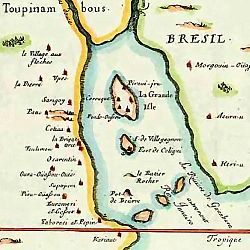France Antarctique
France Antarctique was the name of the failed French colonization attempt south of the equator , which took place between Rio de Janeiro and Cabo Frio from 1555 to 1567 .
Brazil was discovered in April 1500 by a fleet led by Pedro Álvares Cabral on behalf of the Portuguese crown, which landed in what is now Porto Seguro , Bahia . But with the exception of Salvador da Bahia (Brazil's first capital), the rest of the new territory remained largely unexplored for fifty years.
On November 1, 1555, a French Huguenot vice-admiral named Nicolas Durand de Villegagnon (1510-1575) occupied the small island of Sergipe in Guanabara Bay , where today's Rio de Janeiro lies, with a small fleet of two ships and 600 soldiers and Huguenot settlers . A fort called Fort Coligny was built on this island in honor of Gaspard de Coligny , a Huguenot admiral who supported the expedition to protect his fellow believers. Villegagnon named the still largely undeveloped mainland village Henriville to honor Henry II of France, who had also supported the expedition (he had equipped the fleet). Still, the French crown failed to make good use of Villegagnon's efforts to expand France's reach in the new world. The settlements violated the papal bull of 1493 that divided the new world between Portugal and Spain . This division was later made even more precise by the Treaty of Tordesillas .
Undisturbed by the Portuguese, who initially took little notice of his landing, Villegagnon expanded the colony in 1556 by bringing in more settlers, this time mainly Calvinists from Geneva . The three ships were led by his nephew Bois le Comte . Villegagnon secured his position by signing treaties with the Tamoio and Tupinambá Indians of the region who fought against the Portuguese. In 1560, however, Mem de Sá , the new governor general of Brazil, was commissioned by the Portuguese government to expel the French. He attacked Fort Coligny with a fleet of 26 warships and 2,000 soldiers and destroyed the fortress within three days. However, he did not succeed in finally beating the residents and defenders, as they were able to flee to the mainland with the help of the Indians , where they continued to live and work. Villegagnon had returned to France in 1558, repulsed by the religious tension that existed between French Protestants and Catholics who had also come with the second group.
Influenced by two Jesuits , ( José de Anchieta and Manuel da Nóbrega ), the governor general instructed his nephew Estácio de Sá to prepare a new attack. Estácio de Sá founded the city of Rio de Janeiro on March 1, 1565 and fought the French for two more years. With the help of a military reinforcement sent by his uncle, he achieved the final victory over the French forces on January 20, 1567 and drove them out of Brazil. However, a month later he succumbed to an arrow wound which he sustained in battle. Coligny's and Villegaignon's dream had lasted only twelve years.
The two French attempts to conquer territory in Brazil were mainly responsible for the decision of the Portuguese crown to step up colonization efforts in Brazil.

